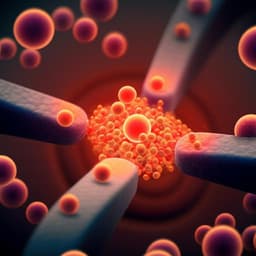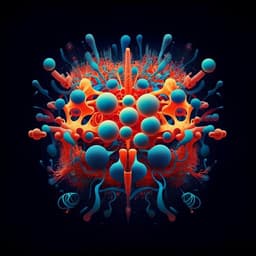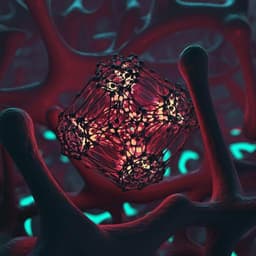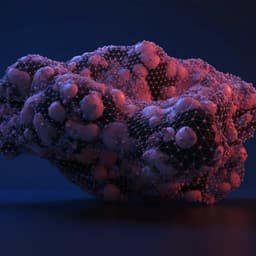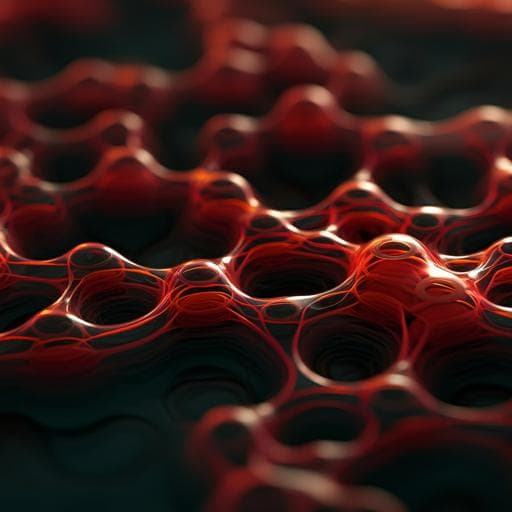
Engineering and Technology
Open-source interactive design platform for 3D-printed microfluidic devices
Y. Zhang, M. Li, et al.
Discover Flui3d, an innovative open-source software platform that revolutionizes the design of 3D-printed microfluidic devices. Created by Yushen Zhang, Mengchu Li, Tsun-Ming Tseng, and Ulf Schlichtmann, Flui3d features a comprehensive component library and unique DFM capabilities, making microfluidics accessible to all through a simple web interface.
~3 min • Beginner • English
Introduction
The study addresses the challenge of efficiently and reliably designing microfluidic devices specifically for 3D printing, where small features and multilayer structures are difficult to realize due to light penetration, resin and printer characteristics, and the lack of domain-specific CAD and automation tools. Although 3D printing has democratized fabrication and enabled rapid iteration, general-purpose CAD tools are not optimized for microfluidic design and require significant manual effort and expertise. Existing microfluidic EDA tools focus on 2D, continuous-flow devices and do not support 3D-printed or multilayer designs. The purpose of this work is to reduce barriers by introducing Flui3d, a web-based, open-source, domain-specific platform that streamlines design, integrates manufacturability constraints, and outputs printing-ready models. The study is important because it expands access to low-cost, 3D-printed microfluidics, supports multilayer miniaturization, and reduces design time and complexity for researchers and practitioners.
Literature Review
The paper surveys microfluidics applications (e.g., diagnostics, microphysiological systems, drug testing) and the shift from traditional fabrication (e.g., lithography, PDMS bonding) to 3D printing, particularly stereolithography (SLA/DLP/MSLA), which offers high precision but suffers from light penetration through transparent resins causing unintended curing. Prior approaches include customized printers and resins, which are not broadly accessible. In design automation, state-of-the-art tools (Cloud Columba, 3DµF, Micado, Fluigi) automate aspects of 2D continuous-flow microfluidic design and produce 2D outputs but do not support 3D-printed device design or multilayer fabrication constraints. The need for a domain-specific platform for 3D-printed microfluidics remains unmet, motivating Flui3d’s integration of parametric components, multilayer design, DRC, and DFM tuned to SLA processes.
Methodology
Platform and workflow: Flui3d is an open-source, web-based WYSIWYG design application accessible via browser. The UI includes a design canvas, task and design toolbars, an information/status panel, and a layer control. Users set device dimensions and default properties, add/select layers, place parameterized components from a library, add ports and inter-layer vias, draw channels, round corners, run design rule checks (DRC), and generate STL/SVG outputs. The system automatically converts 2D layout actions into 3D designs and supports saving projects in JSON for sharing and reuse.
Parameterized component library: Flui3d provides standardized, configurable microfluidic components pre-optimized for 3D printing, including chambers; chambers with pillars (configurable rows/columns/radii); serpentine channels (width, length, height, spacing, turns, corner radius); Tesla valves (segment parameters); droplet generators (disperse/continuous/droplet widths and lengths, height); channel width transitions; and channel height transitions. Components are parameterized to enable rapid O(1) placement and editing, improving consistency and reducing manual drafting.
Custom components: Users can create custom components by composing solid/hollow/stroke primitives (polygons, circles), combining them with channels and library parts. Designs can be exported and shared (e.g., via open repositories) to build community component collections.
Multilayer design and 3D features: Flui3d’s layer control aids multilayer design with color-coded layers, selective focus, and easy addition/removal/repositioning of layers. A bridge function inserts arch bridges to avoid same-layer channel crossings, exploiting 3D printing’s ability to produce overpass features.
Design rule check (DRC): Configurable rules include minimum channel width, minimum component spacing, minimum port/via radii, out-of-bound checks, and overlap detection within layers. DRC flags violations before output.
Design-for-manufacturing (DFM): To counteract SLA light penetration and unintended curing, Flui3d offers compensation during output:
- Local compensation dynamically increases feature heights per layer based on exposure attenuation modeled by Beer–Lambert law I(z)=αe^{-βz}. Compensation C(z) is proportional to accumulated intensity and is approximated using user-specified calibration pairs (Cmin at Zmin and Cmax at Zmax). The system estimates parameters (including an offset K) to compute per-layer compensation values and provides a reference calibration design and procedure.
- Global compensation inserts a blank height after each feature layer to extend optical path length, reducing stray curing between layers. This is especially helpful for multilayer designs or low-power printers requiring longer exposures. Users tune compensation magnitudes to avoid instability or layer cross-over.
Outputs and fabrication: Flui3d exports STL for 3D printing and SVG for other fabrication methods. The authors demonstrate the workflow by designing a three-layer, three-way mixer in under 5 minutes and fabricating it on consumer-grade DLP/MSLA printers (Anycubic Photon D2; Elegoo Mars 4) with multiple resins (Miicraft BV-007A, Anycubic Plant Based + Clear, Liqcreate Bio-Med Clear). Printer/slicer and DFM settings are detailed in supplementary notes.
Evaluation on literature designs: The team replicated seven published devices (including protein immunoassays, resistive microfluidic networks, genotoxic evaluation, SARS-CoV-2 antibody detection, 3D droplet generator, active flow control, and a planar PDMS droplet generator adapted for 3D printing). Designs were recreated in Flui3d, exported as STL, and fabricated successfully using consumer-grade hardware.
Design complexity analysis: Design effort was estimated as total user actions across stages (base design, components, connections, assembling) and compared between generic 3D CAD tools (Shapr3D, AutoCAD, Inventor, SolidWorks) and Flui3d. Because library components in Flui3d reduce per-component complexity from O(n) (n = number of primitive shapes/lines) to O(1), overall device design complexity is substantially reduced. Supplementary materials provide per-stage counts.
Key Findings
- Accessibility and speed: A three-layer, three-way mixer was designed to print-ready STL in under 5 minutes using Flui3d’s guided workflow and component library.
- Manufacturability on consumer-grade printers: All demonstrated designs, including seven replicas from the literature, were successfully fabricated on consumer-grade DLP/MSLA printers (Anycubic Photon D2; Elegoo Mars 4) using multiple resins (Miicraft BV-007A, Anycubic Plant Based + Clear, Liqcreate Bio-Med Clear).
- Effectiveness of DFM: Local and global compensation mitigated unintended curing due to light penetration in SLA processes. Printing without DFM led to clogged or failed features in tested examples, while DFM-enabled outputs printed successfully. Global compensation added blank height between layers; local compensation adjusted feature heights per layer based on Beer–Lambert modeling calibrated by user-provided Cmin@Zmin and Cmax@Zmax.
- Miniaturization: Some multilayer literature designs (e.g., protein immunoassays and genotoxic evaluation) were reduced in size and printed reliably using DFM without design changes, demonstrating capability for compact multilayer microfluidics on entry-level hardware.
- Reduced design complexity: Across seven literature-derived devices, Flui3d required substantially fewer user actions than generic CAD tools. The parametric library changes per-component complexity from O(n) to O(1), yielding marked reductions in total design effort. A feature comparison indicates Flui3d uniquely combines a standardized microfluidic component library for 3D printing, multilayer design, DRC, DFM, and synthesis with open-source availability.
Discussion
Flui3d directly addresses the need for a specialized, accessible design environment for 3D-printed microfluidic devices. By combining a parametric component library, multilayer-aware editing, DRC, and SLA-specific DFM, the platform reduces design complexity and increases the likelihood of first-pass print success on widely available consumer-grade printers. The replication and successful fabrication of seven literature devices and a rapid three-layer mixer design validate the approach. The DFM scheme—particularly local and global compensations tuned by simple calibration—enables reliable printing of small and multilayer features and supports miniaturization without resorting to custom printers or resins. These findings demonstrate that domain-specific design automation can lower barriers, accelerate iteration, and improve manufacturability in microfluidics. Remaining gaps include expanding component coverage and refining rules/compensation models for broader applications and higher precision.
Conclusion
The paper introduces Flui3d, an open-source, web-based design automation platform for 3D-printed microfluidics that streamlines design through a parameterized component library, multilayer co-design, DRC, and SLA-oriented DFM. Demonstrations show rapid creation of print-ready designs, successful fabrication of multiple literature-derived devices on consumer-grade printers and resins, and significant reductions in design complexity relative to general-purpose CAD tools. Future work includes expanding and standardizing the component library, extending DRC rule sets for diverse application contexts, and improving DFM precision beyond Beer–Lambert approximations through more accurate modeling and automated calibration workflows. These advances will further enhance reliability, scalability, and ease of use for 3D-printed microfluidic device design.
Limitations
- Component library scope: Currently limited in breadth and standardization; requires expansion and curation for broader applications.
- DRC/DFM rule coverage: Presently provides fundamental rules (e.g., minimum widths, spacings, radii, boundary and overlap checks). Different applications need tailored rule sets; the rule library needs extension.
- DFM modeling assumptions: Compensation calculations rely on Beer–Lambert approximations using user-provided parameters; accuracy depends on printer/resin/settings and ambient conditions. More precise models and calibration methods are needed to improve predictiveness and robustness.
Related Publications
Explore these studies to deepen your understanding of the subject.



